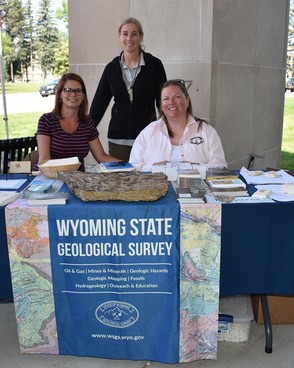|
Three-year-old Noah was among the more than 700 people who attended July 9th’s Dino Day at the Wyoming State Museum in Cheyenne. The WSGS participated in the event, which was part of the museum’s Family Days outreach program. WSGS Director and Wyoming State Geologist, Dr. Erin Campbell, and staff Christina George and Jill Ottman handed out fossil bits, rock samples, posters, postcards, and headlamps to the many fossil, dinosaur, and rock enthusiasts who visited the WSGS table. It was the first in-person event the WSGS has participated in since 2019, and the agency looks forward to future collaborations with the state museum.
 |
The WSGS published new geologic maps in early summer of four quadrangles in the state—1:24,000-scale bedrock geologic maps of the Richards Gap quadrangle (Sweetwater County, Wyoming, and Daggett County, Utah) and Goat Mountain quadrangle (Albany and Laramie counties), 1:100,000-scale surficial geologic map of the west half of the Jackson Lake quadrangle (Teton County), and 1:100,000-scale bedrock geologic map of the Rock River quadrangle (Albany, Laramie, and Platte counties).
WSGS maps are available as free downloads and as hard copies for purchase from the agency’s sale site.
The maps were published with joint funding from the U.S. National Cooperative Geologic Mapping Program (STATEMAP) managed by the U.S. Geological Survey. The WSGS has participated in the program for more than three decades, producing more than 100 geologic maps.
To read more about each of the four mapping projects, see the news release.
After the completion of the maps listed above, WSGS geologists headed to the field this summer to gather data for another set of maps, detailed below.
1:24,000-scale bedrock geologic map of Oil Mountain 7.5' quadrangle, Natrona County
The Oil Mountain quadrangle is about 15 miles west of Casper and at the southeastern margin of the Wind River Basin. This project builds upon recent WSGS studies of subsurface geology in the nearby Powder River Basin as well as nearby mapping efforts in the Wind River Basin and recent work on similar stratigraphy in the Greater Green River Basin. The goal is to better characterize the mineral and energy resources of the Casper arch and southeastern Wind River Basin.
1:24,000-scale bedrock geologic map of Phantom Lake 7.5' quadrangle, Carbon County
The Phantom Lake quadrangle is on the western flank of the Medicine Bow Mountains, about 17 miles southeast of Saratoga. This project continues the WSGS’s larger effort to map the mining districts in the Medicine Bow Mountains, and will focus on documenting mineralization related to regional structure, lithology, and petrology trends. Extensive geochronology and geochemical analysis of units within the map area will assist in identifying mineralization and potential deposits of critical minerals in the map area, and better establish age relationships between the Precambrian units. The final product will compile, refine, and contribute to previous mapping efforts in the area and will be published as a map series.
1:100,000-scale surficial geologic map of east half of the Jackson Lake 30' x 60' quadrangle, Teton, Fremont, and Park counties
The map area encompasses the southwestern Absaroka Range, northern Gros Ventre Range, and easternmost Jackson Hole, and is crossed by the Gros Ventre and Buffalo Fork rivers. The project complements WSGS surficial geologic mapping of the west half of the quadrangle from 2020. This work will generate data related to landslides, possible Quaternary faults, and glacial geology, and will contribute to the understanding of the region’s Quaternary geologic history and active geologic hazards.
 A geologist stands next to interbedded sandstones and mudstones in a cut bank exposure of the Sundance Formation on the Goat Mountain quadrangle.
Since its launching in 2016, the Interactive Oil and Gas Map of Wyoming continues to be one of the most popular WSGS products, one reason being the annual updates geologists make to the online map as new information becomes available. This year’s changes involve redefining oil and gas field boundaries and attributes to include wells drilled and producing during the previous year, re-verifying oil refinery and gas processing plant attributes and status, and revising well layers. The 2021 update includes a new layer delineating the location of wildcat wells.
To learn about the latest update, see the news release.

A series recognizing staff and their contributions
David Lucke—GIS/IT Coordination, 15 years
What do you do at the WSGS? I work with GIS (Geographic Information System) to help provide spatial data to the public.
What makes your job interesting? It always makes me happy to see people succeed; when I provide resources for them, I feel accomplished.
How does your job help Wyoming? Maps! Not only geology but maps are also used for hunting, hiking, and tourism. Our geologic maps assist in providing revenue for Wyoming.
What are some of your favorite geologic features in Wyoming? Medicine Bow Peak. I can see the quartzite from my breakfast table. Mirror Lake and Lake Marie are some of my favorite kayaking spots.
|
|